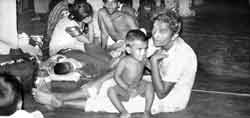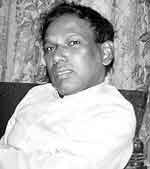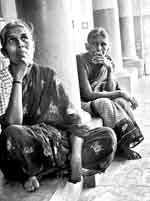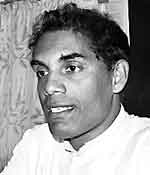THROWN ON LIFE’S SURGE The Church of Our Lady of Victories is packed. But the men women and children gathered in the sprawling compound are not worshippers. They are all waiting for their final port-of-call - India.
According to estimates of the UNHCR, Navy, Police and aid agencies both here and in India, more than 1,700 people have landed on Indian shores, in the first mass exodus from Sri Lanka, in more than four years. The outflow from Sri Lanka began on January 12, amid a surge of north-east violence that has sharply risen since May 14. On Wednesday, The Sunday Times witnessed the Sri Lanka Navy apprehending seven boats carrying 119 people. It was the largest number of refugees since the present exodus began. Mannar island has always been a popular point to cross over to India's southern coast, because of its strategic location. But this time the people going across are not from Mannar or its vicinity but from Trincomalee, on the opposite side of the coast. Since May 14, the Navy has nabbed 187 refugees heading to India, illegally, according to Thalaimannar police. The Navy admits that many more have crossed the seas. Fleeing Trinco Shops pulldown their shutters by 2 p.m. as no one ventures out and the streets are deserted, except for edgy soldiers with their finger on the trigger, at every street corner in the town. The situation has improved since then but authorities are now facing the problem of hordes of Tamil villagers deserting their villages and heading towards Mannar.
Selvarasa Luxshmipillai, 57, was at a vegetable stall with her granddaughter when a powerful bomb placed at the mouth of the Trincomalee market exploded on April 12. "The sound was like thunder, we ran to the shop opposite the market and stayed there for about five hours before we went back home," she said, seated on the edge of a step at the Our Lady of Victories church in the coastal village of Pesalai. Luxshmipillai said, she heard that at least a dozen people were hacked to death in the riots that followed the blast. "It was then that I decided, we had to leave," she said while wearing a red-checked jacket and a purple floral sari, one of the few garments she took with her on a journey to the opposite side of the coast. According to hospital records seen by The Sunday Times, the blast killed 16 people; 8 Tamil, 5 Sinhalese, 2 Muslims and one unidentified person. In the reprisal attacks two Tamils were burned, one Sinhalse shot and two Tamils stabbed. Why Mannar? Tamil refugees first began fleeing to India from Mannar in the aftermath of the 1983 violence. Hundreds were repatriated after the 2002 cease-fire agreement, some with the help of the UNHCR while others returned on their own, the same way they left, by boat across the Palk Strait. However, at least 68,000 Sri Lankan Tamils still live in government-run camps or outside camps in the South Indian state of Tamilnadu. Among those fleeing this time are those who had sought asylum in India before. Duna Romeneshwari, fled to India by boat during fighting in 1990. She returned two years later and married Puhalvenden, who she met in an Indian refugee camp in Selam. This time she is taking a new generation with her. "Every time there is an explosion or shooting we fear reprisals from the forces," she said. "Our children can't go to school, we live in perpetual fear."
Asked why the family travelled half way across the country instead of going to another part of Sri Lanka, she said, "It is not easy to live under the LTTE. We are also frightened that the forces can bomb us at any time. "There is nowhere we feel safe here anymore, that's why we want to go to India.We hear the Indian government there has changed and is more sympathetic towards our plight." Romeneshwari smuggled her 8-year-old daughter last week along with her sister. Now she is waiting with her husband and infant for an opportune moment to cross. Coming in droves After two-three days they take a bus to either Pesalai or Thalaimannar, the last point of transit before negotiating a ride to India which costs between Rs, 8,000-10,000. Ruben Subashini, 29, said she sold whatever gold scraps she had and pawned her thali necklace for Rs. 15,000 to collect money for the boat trip. "We don't want to leave Sri Lanka but we fear for our lives,” she said, nursing her baby boy. "People were saying in Trinco that war was going to break out soon," she said. Subashini's uncle died with about seven others two weeks ago when the boat he was travelling in capsized in mid sea close to India. "I am a little scared to ride with the baby but another mother gave me something to wrap him during the trip," she said, showing us a small transparent sheet. Transit terminal "Even if they get caught by the Navy they will try again," Fr. Patrick said. "Some don't have any idea of what lies in wait for them in India but they just want to leave the country." Fr. Patrick and Fr. Antony Dalima of the Thalaimannar church have been carrying out a daunting task feeding and providing accommodation for the never-ending stream of people. They said they were using parish funds and aid from non-governmental organizations to provide meals for the displaced. Fr. Patrick had held talks with the Divisional Secretary last week and arrangements were being made to transfer the displaced to a welfare center that served as a camp during the war.
Most have spread out mats or sheets in the parish hall, adjoining the church. Some mothers keep their infants in opened out suitcases. The bigger children appear to be happy to play in the sprawling space in the church compound, playing 'hide n seek,' while their parents worry over their fate. The newly-built church is a stones-throw from the seashore where dozens of fishermen set out to the ocean. Among them are an increasing number who are willing to ferry a boatful of people across to India, at a price of course.The men folk seeking refuge at the church, negotiate a price before getting onboard. "I have spoken to many boatmen, as soon as the price is right I will leave with my family," said Ravi Sanka, who says he can't afford to pay 10,000 per person for the ride. The church has literally been turned into an airport. So much so, that Fr. Patrick announced on Wednesday that anyone planning to leave to India will not be given shelter in his church. Risky ride The fishermen there admit that carrying more than 10 people in their small boats was a risk. But this did not deter them packing double the number. After all, it's a lucrative ride. The boat costs Rs. 100,000. One group across earns them almost twice the amount. "We are doing these people a service," said Steven, who declined to give his last name. He had made three clandestine trips in the last week. As night fishing has been stopped since March, the extra cash from the boat ride is a welcome relief, he said. The sun begins to set on the horizon. Suddenly loud screams are heard and the fishermen point to the sea, almost in unison. "There, there the navy has caught two boats," a fisherman said, although there didn't appear to be any surprise in his voice. Two navy fast attack craft are visible on the choppy seas. Not very far behind four boats, packed with people tugged behind. It took a little over an hour for the boats to be taken to the Thalaimannar pier. About half an hour later at 18:30 another boat was apprehended for violating immigration and emigration laws, at 21:30 two more. At the end of the day 34 males, 38 females and 33 children including three infants and 14-boat crew were apprehended. It was the navy's biggest arrest since the exodus began, three days after the LTTE tried to sink a troop carrier off Sri Lanka's northern coast. Among them was a family from Kilinochchi and three families from Vavuniya. The family from Kilinochchi, were afraid to reveal their identity to us because they said they were fleeing through fear of their daughters of 15 and 16 years being recruited by the LTTE. The families spent the night at a church in the navy compound. Usually those apprehended are handed to the police who need to bring them before a magistrate. They are then subsequently released. But because of the large number this time the refugees were handed over to the government agent in the presence of UNHCR officials and subsequently released. The 14 boatmen were handed to the police for legal proceedings while their boats were taken in by the Navy. Uncertainty ahead The Indian government is looking at the situation as a humanitarian problem, a senior official at the Indian High Commission in Colombo said. He said the numbers are still "manageable," but they were concerned about the refugees safety and were monitoring the situation closely. According to figures seen by The Sunday Times, 1,136 people were housed at the Mandapam camp in Tamilnadu alone between Jan. 12 and May 20. Government authorities, UN and other aid agencies have warned against the perilous journey because of increasingly strong winds. "A situation needs to be created where these
people will feel safe, then they will be not compelled to leave,"
said Rt. Rev. Rayappu Joseph, the bishop of Mannar . "Currently,
everything is upside down, there is more war than peace."
|
||||||||
Copyright © 2006 Wijeya Newspapers
Ltd. All rights reserved. |



